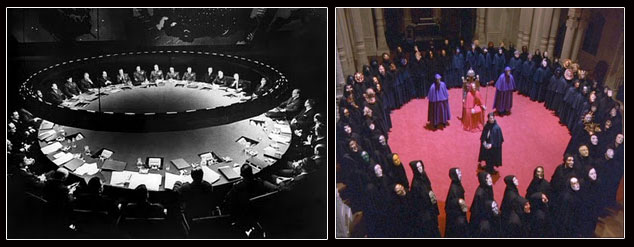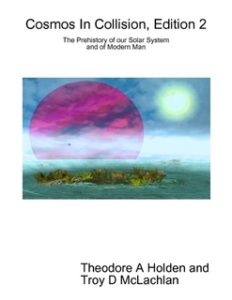Is the greater body of Stanley Kubrick’s films an exposé of a hidden elite obsessed with dark Saturnian sexual rites, paedophilia and the planned ritualistic transmutation of mankind?
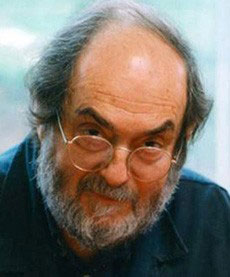
Publicity shot of Stanley Kubrick, rated by many as the finest film director of the 20th century. (image PD)
The author and filmmaker Jay Weidner has proposed that legendary film director Stanley Kubrick created his masterpiece 2001: A Space Odyssey as a visual and alchemical initiation into the ongoing transformation and evolutionary ascent of man to a so-called Star Child destiny.
Set against the backdrop of a space mission sent to the planet Jupiter to investigate a strange artificial monolith, 2001: A Space Odyssey is an almost surreal experience that incorporates thematic elements including human evolution, technology, artificial intelligence and extraterrestrial life. According to Weidner, it is a bold attempt to envision the next evolutionary step for humanity as it reaches out beyond its own planet into the depths of space.
During a March 6, 2011 interview on Red Ice Radio, Weidner asserted that Kubrick had originally wanted to set the story’s monolith on the planet Saturn as it is written in the Arthur C. Clarke novel of the same name and not on Jupiter as it appears in Kubrick’s film. However, the special effects team apparently could not replicate Saturn’s rings well enough and Jupiter was substituted into the plot.
Weidner doesn’t buy this. He believes Kubrick was pressured to make the changes by highly placed occultists worried that the film was too blatant in its depiction of the role played by Saturn in their occult human transmutation agenda. However, from the perspective of this website’s core theme there are enough eerily familiar images in 2001: A Space Odyssey to suggest that Kubrick did in fact get ‘Saturn’ into his film.
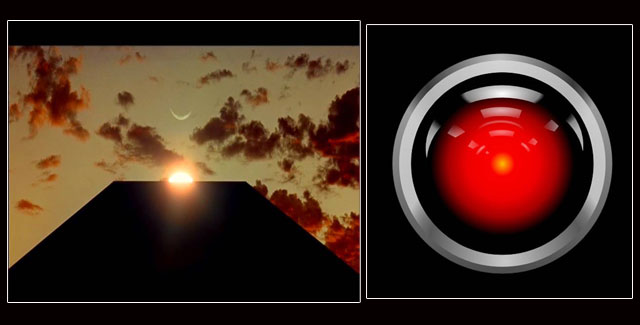
Two iconic images from 2001: A Space Odyssey. Compare with picture below of how a Saturn stationed at Earth's celestial north and connected by a vast auroral Birkeland current might have looked to the ancients during the Golden Age. (images are publicity stills, PD)
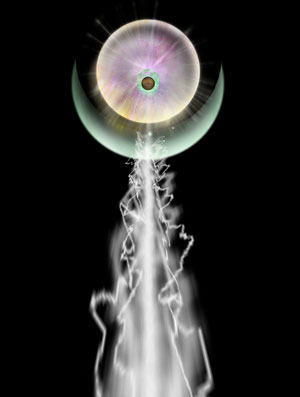 So why did they let Kubrick make 2001: A Space Odyssey in the first place?
So why did they let Kubrick make 2001: A Space Odyssey in the first place?
Well, it all goes back to understanding the context of the times in which Kubrick was working, i.e. the space race with the Soviet Union during the time of the Cold War. But more on this later, because I think it is important to first establish a connection between Kubrick’s films and Weidner’s assertion of his supposed knowledge of an occult agenda and the elite that control that agenda.
Of course, to fully understand Jay Weidner’s take on the works of Stanley Kubrick it is best to visit his website and read his articles on the subject for yourself. In the meantime a short summary of Kubrick’s key films (in no particular order) will give you a hint at what Weidner is getting at.
Eyes Wide Shut: Kubrick’s look into the world of the New York sexual underground, the bizarre rituals of a sex cult, infidelity and possible elite murder. The film is peppered with occult and Masonic visual references and hints at underage prostitution amongst New York’s privileged classes. The film, though butchered by a studio re-edit, is a cause célèbre amongst occult observers as an insider’s peek into the dark sexual practises of the world’s elite. (NOTE: Kubrick died, some say mysteriously, four days after screening his final cut of the movie – it was seriously and suspiciously re-cut after his death)
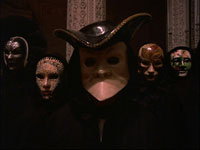
Publicity still from Eyes Wide Shut. The character was the inspiration for the figure at right in this website's headline banner.
A.I. Artificial Intelligence: A Kubrick project largely completed by Steven Spielberg after Kubrick’s death, the film centres around the concept of artificially created children being manufactured as substitutes for childless couples or grieving parents trying to come to terms with the loss of a human child. Once again, it is said that Kubrick’s plot was radically changed after his death from a much darker look into why people would want to create life-like children that never grew up. As Weidner points out: What mother would want to miss out on the experience of watching her child grow into adulthood? Yet, what group of people would want to have a never-aging 12-year old boy? Yep,… paedophiles; of which occult groups count many within their ranks. Was this Kubrick’s intended message for this film?
 Lolita: One of Kubrick’s earlier films that explores the sexual relationship between an older man and an underage girl. Based on the notorious novel of the same name, Kubrick departed from the book’s plot on one significant point – through the enhanced role of Peter Sellers’ character he hints at the existence of a paedophile network active in procuring underage girls. This is a common attribute associated with elite occult activities and we see here Kubrick exploring one of his more enduring themes.
Lolita: One of Kubrick’s earlier films that explores the sexual relationship between an older man and an underage girl. Based on the notorious novel of the same name, Kubrick departed from the book’s plot on one significant point – through the enhanced role of Peter Sellers’ character he hints at the existence of a paedophile network active in procuring underage girls. This is a common attribute associated with elite occult activities and we see here Kubrick exploring one of his more enduring themes.
Dr. Strangelove: The 1964 film that established Kubrick as a special effects master, a very important point to remember in understanding why Jay Weidner believes Kubrick was allowed to make his later occult-exposé films. For its time, however, Dr. Strangelove was the definitive satire on the ominous military industrial complex that President Eisenhower had warned the American people about. Occult influences within the military industrial complex have been a staple of occult-conspiracy literature and Kubrick’s satire underlies his own distrust of this insidious institution.
A Clockwork Orange: The ultimate mind-control movie in which we see a violent rapist transformed by the brainwashing Ludovico technique into a passive citizen devoid of his humanity, albeit violent humanity. In this film Kubrick goes to the heart of a society being steered towards the goal of transmuting people into more pliable subjects. The suspicion that we can all be manipulated by hidden agendas is the uneasy conclusion echoed by this film and highlights a paranoia Kubrick seems to have had regarding authoritarian control mechanisms.
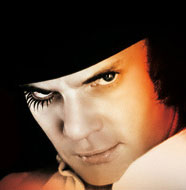
A Clockwork Orange. Note the 'eye' motif, very evocative of the Eye of Horus, a classic Saturnian symbol.
Full Metal Jacket: Another look by Kubrick at humans being dehumanised then transformed, this time with the horrors of the Vietnam War providing the backdrop as a group of US Marines go through basic training and then into combat. Once again the aware observer can pick out Kubrick’s use of human transmutation as an underlying theme being used to explain what is happening to the hapless marine recruits – a metaphor maybe for humanity’s own planned transformation.
2001: A Space Odyssey: Kubrick’s undoubted masterpiece and at the centre of Jay Weidner’s alchemical take on Kubrick’s films. As discussed above, Weidner claims this film to be Kubrick’s attempt at an initiation rite of passage illustrating humanity’s next planned-for evolutionary step. Weidner believes Kubrick has revealed an occult agenda to launch us as a species into space where we will be able to embrace our destiny as future star children and join the greater cosmos.
The Shining: A film crucial to understanding how Kubrick was able to get away with making films laced with occult references and alchemical imagery. Weidner believes this fraught adaption of Stephen King’s novel about an isolated writer going mad (King hated Kubrick’s adaption) is actually a cryptic confession by Kubrick of his involvement in the faking of the Apollo 11 moon landings!
And with that last statement we finally arrive at why Kubrick seems to have been allowed to embark on a career making movies with hidden alchemical messages and occult exposés.
Kubrick’s Apollo 11 deal
I first came across Weidner’s work on Stanley Kubrick when researching possible evidence for a faked 1969 moon landing by NASA. There are many theories claiming that the 1969 Apollo moon mission was faked, but Weidner caught my interest due to his comparative analysis of the moon landing footage with Kubrick’s special effects work in 2001: A Space Odyssey.
What Weidner was able to plausibly demonstrate was that the background sky in the Apollo 11 mission shots shared the same forensic tell-tale signs of Kubrick’s front projection technique used on 2001: A Space Odyssey.
I quote from the blurb to Weidner’s excellent documentary film Kubrick’s Odyssey Part 1:
“In Kubrick’s Odyssey, Part I, Kubrick and Apollo, author and filmmaker, Jay Weidner presents compelling evidence of how Stanley Kubrick directed the Apollo moon landings. He reveals that the film, 2001: A Space Odyssey was not only a retelling of Arthur C. Clarke and Stanley Kubrick’s novel, but also a research and development project that assisted Kubrick in the creation of the Apollo moon footage. In light of this revelation, Weidner also explores Kubrick’s film, The Shining and shows that this film is, in actuality, the story of Kubrick’s personal travails as he secretly worked on the Apollo footage for NASA.”
Having extensive experience in film production myself, Weidner’s technical arguments were powerfully persuasive. What we also learn from Weidner is that Kubrick, in agreeing to fake the moon landings, brokered a deal that allowed him to make any movie he wished from that time on with full artistic control. Kubrick had become an insider in one of the greatest alleged conspiracies of the age, but it was to cost him dearly and he would use his artistic freedom to subtly expose those behind the conspiracy.
The Saturn Death Cult connection
As mentioned in the first paragraphs of this article, Stanley Kubrick had originally wanted to use Saturn and not Jupiter as the location for the alien monolith in 2001.
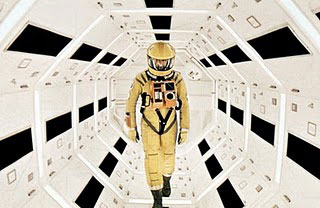
My favourite Saturnian-type image from 2001: A Space Odyssey. Compare with below image depicting a possible Saturn, Venus and Mars configuration during the Golden Age.
Why?
It is evident that in mythological and esoteric traditions, Saturn is recognised as the original supreme creator or god. It is also true, as documented by authors such as Richard C. Hoagland and Joseph P. Farrell, that the US space agency NASA was and is infested with various Masonic, Nazi and occult influences all intent on pursuing their own hidden agendas, and all fully versed in what this writer refers to as corrupted Saturnian lore.
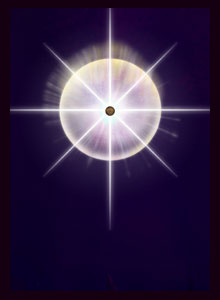 In dealing with these occult NASA insiders while faking the Apollo 11 landings, Kubrick would have been initiated into their perception that humanity’s destiny is inextricably linked to an occult and metaphysical understanding of Saturn. Exposing this twisted metaphysical interpretation of Saturn is the whole premise for this website, but for Kubrick such an interpretation would have been crucial in establishing a true initiation experience for his 2001: A Space Odyssey audience.
In dealing with these occult NASA insiders while faking the Apollo 11 landings, Kubrick would have been initiated into their perception that humanity’s destiny is inextricably linked to an occult and metaphysical understanding of Saturn. Exposing this twisted metaphysical interpretation of Saturn is the whole premise for this website, but for Kubrick such an interpretation would have been crucial in establishing a true initiation experience for his 2001: A Space Odyssey audience.
But, as we have seen, Kubrick was thwarted on that score when he was forced to switch to Jupiter as the film’s main backdrop.
The irony is though, that because most occultists themselves still labour under the notion that the solar system has always been as we see it today, Kubrick would not have realised that there is a perfectly natural explanation for Saturn’s exalted position in mythology. While NASA’s occult jet propulsion engineers and Nazi rocket scientists looked to rediscover some lost Saturnian truth by physically travelling to that planet (Saturn V rockets?), those with an appreciation for the Electric Universe model of the solar system know that Saturn’s mythological secrets lie in its original physical position at Earth’s celestial north.
That occultists and alchemists still cling in ignorance to the accepted uniformitarian view of our solar system would almost be laughable if it were not for one very brutal fact; that they have developed a code of sickening sex-murder rituals over the centuries in pursuit of their quasi-metaphysical reverence for Saturn.
As those who have read this website’s general outline on the Saturn Death Cult know, women and children the world over have suffered the horrific consequences of this insidious interpretation of mythology. If we are to believe the imagery of films like Eyes Wide Shut and A Clockwork Orange, then it seems Kubrick too was exposed to this unsavoury side of the Saturn legacy and his latter films may have been his own attempt to alert us to the existence of this curse. For Kubrick, though, the tragedy is that his artistic genius was badly poisoned by contact with these creatures and it seems he too suffered terribly on a personal level as a result.

